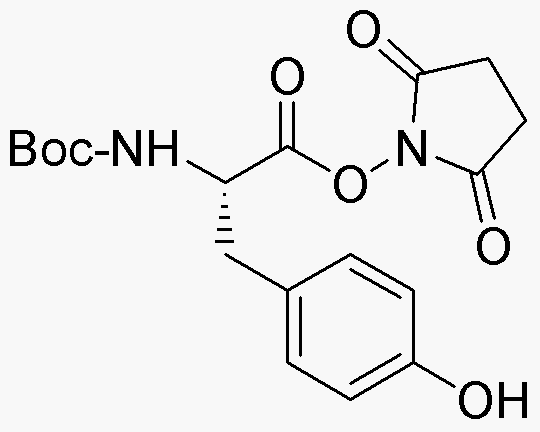Boc-L-tyrosine N-hydroxysuccinimide ester is widely utilized in research focused on:
- Peptide Synthesis: This compound serves as a key building block in the synthesis of peptides, allowing researchers to create complex structures with specific functionalities, enhancing the development of therapeutic agents.
- Drug Development: Its ability to modify amino acids makes it valuable in drug design, particularly in creating prodrugs that improve the bioavailability of active pharmaceutical ingredients.
- Bioconjugation: The ester functionality facilitates the conjugation of biomolecules, which is crucial in developing targeted drug delivery systems and diagnostic tools in the biomedical field.
- Research in Neuroscience: As a derivative of tyrosine, it plays a role in studying neurotransmitter pathways, aiding in the understanding of various neurological conditions and potential treatments.
- Protein Engineering: It is used to introduce specific modifications in proteins, enhancing their stability and activity, which is essential for various applications in biotechnology and pharmaceuticals.
General Information
Properties
Safety and Regulations
Applications
Boc-L-tyrosine N-hydroxysuccinimide ester is widely utilized in research focused on:
- Peptide Synthesis: This compound serves as a key building block in the synthesis of peptides, allowing researchers to create complex structures with specific functionalities, enhancing the development of therapeutic agents.
- Drug Development: Its ability to modify amino acids makes it valuable in drug design, particularly in creating prodrugs that improve the bioavailability of active pharmaceutical ingredients.
- Bioconjugation: The ester functionality facilitates the conjugation of biomolecules, which is crucial in developing targeted drug delivery systems and diagnostic tools in the biomedical field.
- Research in Neuroscience: As a derivative of tyrosine, it plays a role in studying neurotransmitter pathways, aiding in the understanding of various neurological conditions and potential treatments.
- Protein Engineering: It is used to introduce specific modifications in proteins, enhancing their stability and activity, which is essential for various applications in biotechnology and pharmaceuticals.
Documents
Safety Data Sheets (SDS)
The SDS provides comprehensive safety information on handling, storage, and disposal of the product.
Product Specification (PS)
The PS provides a comprehensive breakdown of the product’s properties, including chemical composition, physical state, purity, and storage requirements. It also details acceptable quality ranges and the product's intended applications.
Certificates of Analysis (COA)
Search for Certificates of Analysis (COA) by entering the products Lot Number. Lot and Batch Numbers can be found on a product’s label following the words ‘Lot’ or ‘Batch’.
Número de catálogo
Número de lote/lote
Certificates Of Origin (COO)
This COO confirms the country where the product was manufactured, and also details the materials and components used in it and whether it is derived from natural, synthetic, or other specific sources. This certificate may be required for customs, trade, and regulatory compliance.
Número de catálogo
Número de lote/lote
Safety Data Sheets (SDS)
The SDS provides comprehensive safety information on handling, storage, and disposal of the product.
DownloadProduct Specification (PS)
The PS provides a comprehensive breakdown of the product’s properties, including chemical composition, physical state, purity, and storage requirements. It also details acceptable quality ranges and the product's intended applications.
DownloadCertificates of Analysis (COA)
Search for Certificates of Analysis (COA) by entering the products Lot Number. Lot and Batch Numbers can be found on a product’s label following the words ‘Lot’ or ‘Batch’.
Número de catálogo
Número de lote/lote
Certificates Of Origin (COO)
This COO confirms the country where the product was manufactured, and also details the materials and components used in it and whether it is derived from natural, synthetic, or other specific sources. This certificate may be required for customs, trade, and regulatory compliance.


